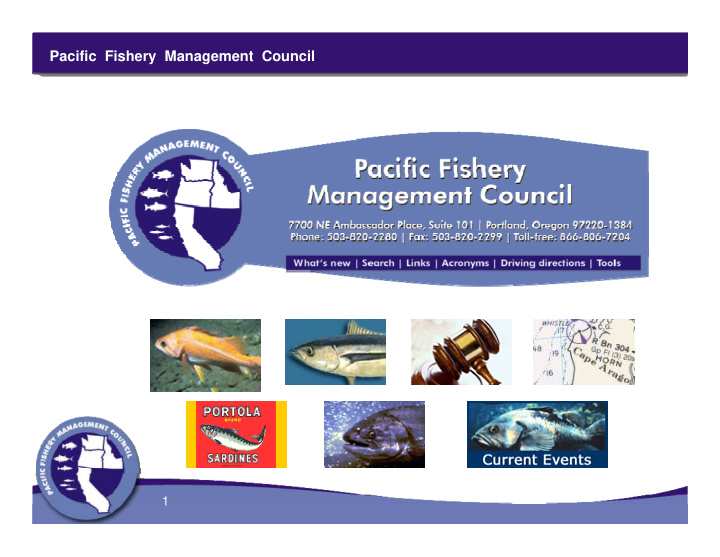



Pacific Fishery Management Council 1
Pacific Fishery Management Council Frequency and Duration of Meetings • Full SSC meets during regularly scheduled meetings of the Pacific Council o March, April, June, September, and November • SSC typically meets for two days at the beginning of the Council week 2
Pacific Fishery Management Council Process of Public Input • Time is scheduled on each SSC agenda for public comment • Prerogative of Discussion Leader or SSC Chair to solicit input from general public in attendance 3
Pacific Fishery Management Council Composition and Recruitment of Members • 17 Designated SSC members o One member from each State’s fish management agency � Washington Dept. of Fish and Wildlife � Oregon Dept. of Fish and Wildlife � California Dept. of Fish and Game � Idaho Dept. of Fish and Game o Five designated from NMFS Centers � One from Alaska Fisheries Science Center � Two from Northwest Fisheries Science Center � Two from Southwest Fisheries Science Center 4
Pacific Fishery Management Council Composition and Recruitment of Members (continued) o One member from a West Coast Tribal fish management agency o Seven at large positions � Recruited from academia, NMFS, Tribal fish management agencies, and consultants 5
Pacific Fishery Management Council Terms and Selection of Officers • SSC Chair and Vice Chair are elected by common vote of all SSC members every two years Typically, Vice Chair assumes the Chair after the o two ‐ year term with a vote of affirmation 6
Pacific Fishery Management Council Development of Advice to the Council • Council staff identifies items for SSC review and produces a draft SSC agenda for approval by the SSC Chair prior to the meeting • SSC Chair identifies one SSC member as a discussion leader and one as a rapporteur for each agenda item • Council staff schedules one or more experts to discuss agenda item with SSC and answer questions 7
Pacific Fishery Management Council 8
Pacific Fishery Management Council Roles of Discussion Leader and Rapporteur • Discussion Leader Ensures the agenda item is thoroughly discussed and o focuses on the matters important to the Council Ensures all SSC members have their questions answered o By end of discussion, advice needed by Council has been o provided • Rapporteur Main points of SSC discussion are captured in statement o Strengths and weaknesses of the science under o discussion are relayed to the Council Conclusions and recommendations of the SSC to the o Council are clearly stated 9
Pacific Fishery Management Council Statement Development and Review • Statement preparation can be an arduous process involving two to three, and sometimes four, iterations of the SSC reviewing the draft statement prepared by the rapporteur • Once the SSC has finalized its statement, copies are provided to Council members and made available to the public • The SSC Chair, or a designated SSC member, reads the statement to the Council and answers any questions the Council may have concerning the statement itself, or the discussion that occurred in the SSC 10
Pacific Fishery Management Council 11
Pacific Fishery Management Council Development of Research Priorities The PFMC’s Council Operating Procedure (Number 12) addresses “Update and Communication of Research and Data Needs”. It specifies that the Council “will update and maintain a research and data needs document which lists and prioritizes unmet Council research and data collection needs for each fishery management plan”. • Goal is to update this document every five years Can be modified outside of 5 ‐ year cycle o • Preparation of this document is primarily the responsibility of the SSC Assistance from Council Staff o Input from Council advisory bodies o • Council approves draft for public review 12
Pacific Fishery Management Council Document Review and Staff Presentations • Much of the in ‐ depth review occurs at the SSC subcommittee level There are currently six subcommittees within the SSC o � Salmon � Groundfish � Coastal Pelagic Species � Highly Migratory Species � Economic � Ecosystem ‐ based Management Subcommittee membership is voluntary but each SSC o member is encouraged to participate in at least two subcommittees 13
Pacific Fishery Management Council Document Review and Staff Presentations • Subcommittees provide a number of functions Review of technical issues that require more time than can o be allocated at a regularly scheduled SSC meeting Coastal Pelagic and Groundfish Subcommittees provide a o Chair for each Stock Assessment Review (STAR) Panel under their oversight and sometimes an additional reviewer Salmon subcommittee meets every October to review new, o or substantially revised, methodologies and models proposed for the upcoming salmon management cycle Preparation of “white” papers to address issues of ongoing o concern to the Council Plan and coordinate workshops addressing technical issues o important to the PFMC 14
Pacific Fishery Management Council Scientific Peer Review Process of Impact Analyses (EA/RIR/IRFAs) and Other Reports • The SSC does not review these types of documents in their entirety. If there are analyses or models presented in one of these documents that the Council or document developers wish to have reviewed, it would occur through the process described above. 15
Pacific Fishery Management Council Procedures of Decision ‐ making • The SSC of the Pacific Fishery Management Council is a consensus body. All statements regarding items on the agenda that are providing advice to the Council are developed by the SSC as a whole and approved by consensus. 16
Pacific Fishery Management Council Pacific Fishery Management Council Preparation of Minutes • Council Staff assemble all statements that are produced by the SSC during the meeting into the minutes of that meeting for SSC review and approval at the next meeting. 17 17
Pacific Fishery Management Council Pacific Fishery Management Council QUESTIONS ? 18 18
Recommend
More recommend